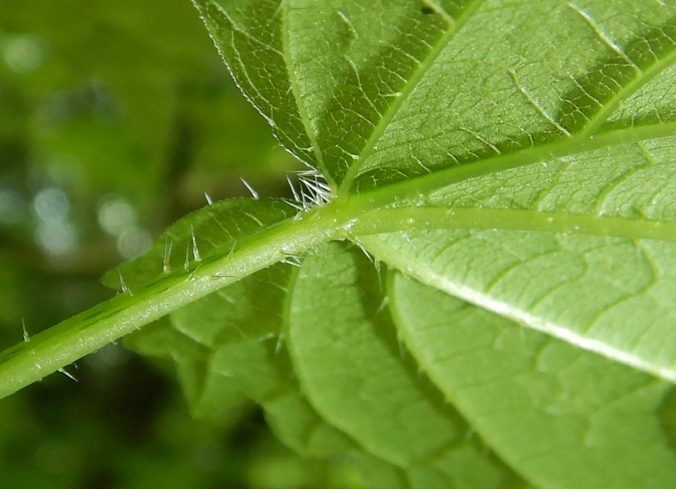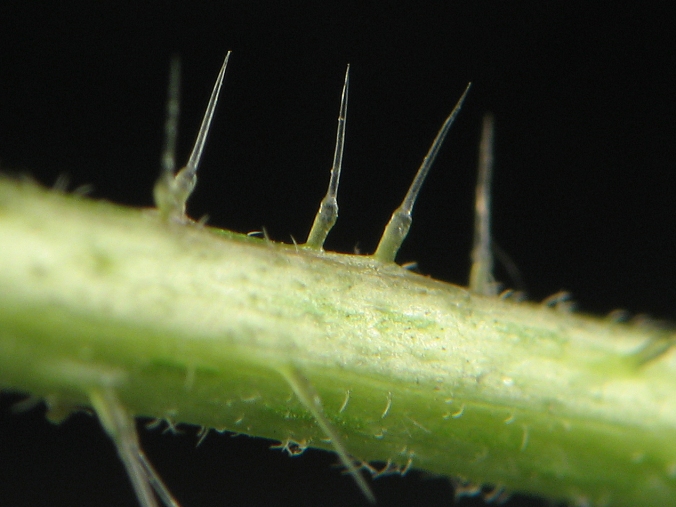My neck of the woods isn’t like the Chihuahuan Desert, where nearly everything that photosynthesizes seems like it evolved to grab, shred, tear, puncture, and stab you (just try an off trail hike at Carlsbad Caverns National Park if you want the experience and say hello to the lechuguilla while you do). Nor is my habitat like the poison-oak dominated slopes found in coastal California where a careless walk through brush can leave you itchy for weeks. No, not like that. Heck, I don’t even need to worry about ticks.
Along the Skagit River, devil’s club and a couple of species of invasive blackberry will stop you in your tracks with their numerous, stout thorns. Besides those few, the list of plants to avoid drops off fairly quickly, with a notable exception. One of the most ecologically interesting and menacing members of my plant community is a nondescript perennial that’s easy to ignore until it’s too late.
Lots of plants are fuzzy with fine hair. Some plants, like common mullein (Verbascum thapsus), utilize hairs on their leaves and stem like sunscreen and to make grazing just a little uncomfortable for herbivores. Some hair is just there, perhaps not serving a specific adaptive purpose, or not one that we know currently. But one plant in my forest, Urtica dioica or stinging nettle, has turned their hairs up to 11.
Nettle is rather inconspicuous. It has oppositely-arranged, coarsely-toothed, and heart shaped leaves. Its flowers grow in small, string-like clusters from the leaf axils and lack petals, typical for a wind pollinated plant, but what it lacks in showiness it makes up in its ability to inflict pain.

Stinging Nettle (Urtica dioica)
I learned about stinging nettle as a young teenager scrambling up a creek bank in Pennsylvania. The bank was steep and muddy. I needed just a little extra support to prevent me from sliding down. Lacking a tree to hold, I grabbed a group of herbaceous stems and immediately realized I had made a mistake. I made it up the bank, but the palms of my hands burned for the rest of the day. I was just introduced to nettle’s defense against mammalian herbivores.
Stinging nettle is equipped with tiny, but potent, stinging hairs. On the plants in my area, the hairs are particularly concentrated on the stems, flowers, petioles, and leaf undersides. Each hair is tipped with a small, fragile bulb that breaks off when contacted to expose a needle-like tip that, hardened by calcium carbonate and silica, readily injects a cocktail of chemicals into your skin. The stinging sensation is immediate and long lasting.


Among other chemicals, the juice inside a hair contains histamine, which is an inflammatory compound (we take antihistamines to inhibit the affects of allergic reactions), and serotonin, which constricts blood vessels and acts as a neurotransmitter. In sum, it is designed to irritate.

Photo courtesy Jerome Prohaska and Wikipedia.
Why the need for this defense? Nettle leaves are nutritious and high in vitamins A and C as well as protein. They would likely be a sought after commodity by deer and other browsing mammals if it weren’t for their stinging hairs.
We can neutralize the sting by drying or steaming the leaves. Steamed, the leaves taste as mild as spinach and they make a decent pesto.
The rash you get from poison ivy is an accident of evolution. The oily liquid, urushiol, which causes the itchy dermatitis on us doesn’t affect other North American mammals or birds. Your dog won’t get it. Deer eat the leaves. Many bird species relish poison ivy fruits for food. The stinging hairs on nettles tell a different story. They are purposefully indiscriminate against all mammals.
Plants, like all life forms, experience a wide variety of limiting factors. Stinging nettle may have evolved one way to dissuade herbivorous mammals, but the same defense doesn’t deter insects or snails. The stinging hairs don’t work on parasitic fungus or microorganisms either, nor on anything that attacks and eats its perennial rhizome. But, its stinging hairs work, quite well in fact for their evolved purpose—discouraging mammals from eating it.
Despite the pain nettle can inflict, I look forward to seeing it sprout each spring. It gives me an opportunity to reflect upon why it needs to evoke such discomfort in mammals. Stinging nettle is a plant with teeth. It fights back.




Growing up in Ireland we learnt to always leave dock weeds growing in our garden & to rub them on the sting as fast as possible. Might be folklore that it counteracts the sting & that it just offer a cooling placebo effect but for me it still works. Got stung again pulling up potent young nettles from old flower beds in my dad’s garden. Fortunately the dock leaves had just unfurled too.
LikeLiked by 1 person
Nature had evidently decided it had been much too long since I recognised a stinging nettle when I learned my irritating lesson last summer. I’d have sold my soul for one of those dock leaves, old wives’ tale or not 🙂
LikeLiked by 1 person
Pesto??? Mamma Mia… Seriously??? Oh, where is Juergen to comment on that one! 😉 I will show this to my Italian colleague at work, who taught me all about pesto and he did it the hard way – wasn’t nice 😀 And I will then tell you his comment… Italians are totally orthodox about their food (and I mean totally, totally, like if you dare to have a cappuccino with your breakfast instead of espresso, they think you’re a serial killer). And let’s see what Donna Ann has to say about it, too (she’s of Italian origin and can cook Italian food like a goddess). So – Mike – you’ve stepped on Very Slippery Ground here 😀 Nettle pesto… Geez – it’s like pouring vinegar on pancakes instead of maple syrup. And feeding the result to a bear. :-))))
LikeLiked by 1 person
Here in Italy it is called ortica, it is quite common and also used in the kitchen. A tipical dish is “ravioli all’ortica” for example. Thanks Mike for your interesting posts.
LikeLike
Wow, “ravioli all’ortica” sounds great – do you put the nettles in the sauce or in the filling?
LikeLike
Ranger Mike, Thank you for your very interesting article “A Plant With Teeth”. Tom
LikeLike
So very interesting, Mike! I guess by your description that you have tasted these pesky leaves – so you got back at the ones that hurt you when you were younger!
LikeLike
Oh yes. I made about a quart of nettle pesto just before writing the post.
LikeLike
Thanks Mike; so many recipes online for stinging nettles. Yes, pesto is one of them. High in vitamins and minerals. Will ask around at the farmer’s market to see when it is in season. Looks like a winner!!
LikeLike